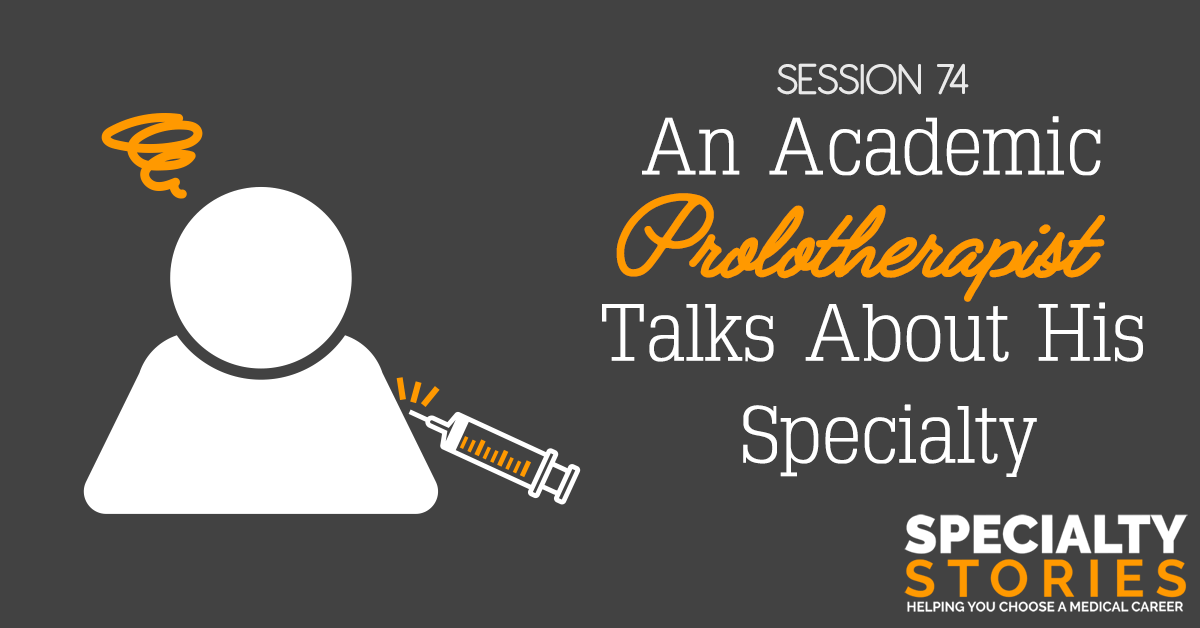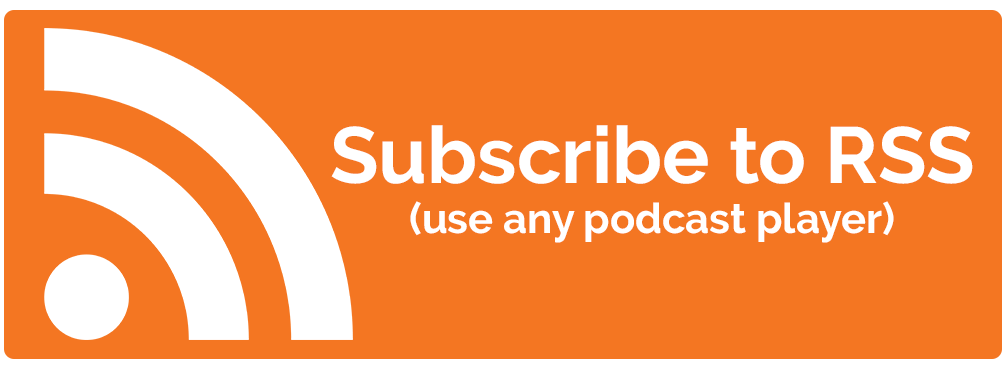[smart_track_player url=”http://traffic.libsyn.com/specialtystories/SS74.mp3″ color=”004075″ title=”A Community Prolotherapist Talks About His Specialty” ]

Session 74
Dr. Ross Hauser is residency trained in physiatry and has gone on to train in prolotherapy. He talks about what it is and why it’s the future!
Ross is very passionate about prolotherapy. If you want to learn more about this, visit his website on Caring Medical.
Also, check out all the rest of our episodes on MedEd Media Network, including The Premed Years Podcast, The MCAT Podcast, The OldPreMeds Podcast, Ask Dr. Gray: Premed Q&A, and some more coming in the future!
[02:05] Interest in Prolotherapy
In the last two months of his residency, Ross had an elective rotation which he did with prolotherapist Dr. Hamwell back in 1992. Then he joined the physician in 1993, so he has been a prolotherapist for over 25 years.
Ross describes himself as always liking old people. Thinking he was going to be a geriatrician initially, it was during his chronic pain rotation in his physiatry residency that he discovered his love of the mystery of pain. He was told by the physician he rotated with that most structural chronic pain is from joint instability or ligament laxity. And the curative treatment in a lot of people was prolotherapy. So he wanted to go for the cure instead of pain management.
[04:15] What is Prolotherapy?
The term prolotherapy was originally coined by Dr. Hackett, in short for proliferative therapy. The treatment is designed to cause the proliferation of cells, which make the extracellular matrix made up of ligaments, tendons, cartilages, or whatever you’re trying to regenerate.
In the Webster’s International New Dictionary, prolotherapy is defined as the rehabilitation of an incompetent structure such as a ligament or tendon by the induced proliferation of cells.
So if a person has a tendon or ligament tear, you want to proliferate the fibroblasts, the actual cells in the body that make the ligaments or tendons. You want to proliferate those cells so they can then regenerate the ligaments or tendons.
Ross goes on to explain that the body’s response to an unstable joint is to try itself to limit motion. One of the ways it does is it causes synovitis resulting in a very low level type of inflammation in the joint. Since medical doctors have been trained to very quickly try to get rid of symptoms, that’s why treatments have gone more toward a treatment that dissolves the pain quickly.
[Tweet “”Medical doctors have been trained to very quickly try to get rid of symptoms, that’s why treatments have gone more toward a treatment that dissolves the pain quickly.” https://medicalschoolhq.net/ss-74-a-community-prolotherapist-talks-about-his-specialty/”]
However, 97% of tendon tear, for instance, occur in a degenerated tendon. Under a microscope, a degenerated tendon has way less cells than a normal tendon. So there’s fewer cells to regenerate for a degenerated tendon. So the best curative type treatment for this is prolotherapy.
The problem is that beside physiatry, prolotherapy is now becoming one of the standards of care for pain treatment. But in other fields like family practice, a doctor has to get training after residency. But once you get into practice, you get too busy to even get training. Ross hopes medical schools and residency programs recognize that the cause of osteoarthritis or a degenerative disease is ligament laxity or joint instability. Apparently, they have to shift to this paradigm. Otherwise, they won’t be able to emphasize prolotherapy.
[08:22] PRP vs. Prolotherapy
PRP stands for Platelet Rich Plasma. Ross explains the inflammatory cascade where when tissue injures and there’s bleeding, platelets rush to the area and change their shape to stop the bleeding. When they do this, they release growth factors. To simulate the way the body heal for a degenerated joint, they take the blood out and centrifuge the blood. They get the plasma out and then you’re left with just the platelets, which are then injected into the injured area like the shoulder or lower back.
[Tweet “”Platelet rich plasma is one of the more natural solutions we use in prolotherapy to proliferate cells.” https://medicalschoolhq.net/ss-74-a-community-prolotherapist-talks-about-his-specialty/”]
[09:33] Traits that Lead to Becoming a Good Prolotherapist
Ross explains that until that paradigm changes, until we stop trying to resolve symptoms and we start trying to treat the actual structural cause of the pain, which is joint instability, in medicine, we’re going to be led astray. We’re still going to use pharmaceuticals.
[Tweet “”There’s no pain that the underlying cause is a drug deficiency. We want to be healers in the truest sense and cure problems instead of covering up the symptoms.” https://medicalschoolhq.net/ss-74-a-community-prolotherapist-talks-about-his-specialty/”]
If you want to become a good prolotherapist, you’ve got to commit to it. He says that if you only do a bit of this and that, you’re never going to be an expert. If you get the skill set to document the instability and treat it with prolotherapy, then the next visit, you look at the tissue. So if you find something to be true, commit to it. Treat your patients that way and document your results. That means if somebody doesn’t come back, you have to call them. So you have to follow up and have to commit.
[14:15] Types of Patients and Typical Day
The average person they see is a middle age to older age that had a degenerated tendon that the tendon just tore. The more degenerated tendon means there’s less and less cells to regenerate. A degenerated tendon is a lot weaker than a normal tendon. So it gets weaker and weaker until it tears.
With prolotherapy, they use ultrasound guidance to put the PRP into where the tendon tear is. They’re also doing comprehensive prolotherapy into the ligament support of the shoulder. So they’re resolving the joint instability and also helping the tear repair.
The’ve also done pubis ligament. Ross explains the more children a woman has, the looser the pubis. And a lot of people think this is a hip or back problem but it’s really a loose pubis. What they do is have them put on compression shorts to keep it tight and then they do prolotherapy to tighten the ligament support. Most people also don’t realize there’s a disc in the pubis. Ross describes this as a strange joint, since you don’t typically talk about it in medical school.
[Tweet “”100% of them think they know the problem the doctor gave them. But 75% of the time, they’re wrong.” https://medicalschoolhq.net/ss-74-a-community-prolotherapist-talks-about-his-specialty/”]
Ross points out that with ultrasound technology, it can locate all the nerves of the body. It’s very easy by history to tell when it’s a compressed nerve and what’s a joint problem. But with our technology now, they can already tell whether the nerve is swollen or not and measure it. Ultrasound scanners now are so detailed. He can even now see the vagus nerve in the carotid sheath. It’s unbelievable what a doctor in their own office can see.
Ross would work half a day with patients, like 5 solid hours seeing patients. He would see patients at 8 am. His staff gets the patients going although they review the patients the night before. Some are new, others are follow ups. They try to figure out whether a patient needs a motion scan. In that case, they’d have to numb the musculature in the back of the neck so the muscles can’t limit the joint motion. Then they’ll do a fluoroscopic evaluation of them moving their neck to see where the instability is.
So the first thirty minutes, he’d do emails and by 8:30, he’d begin seeing the patients after the staff had gotten them ready. Then he will start treating people. Whoever gets scanned, his assistant does ultrasound exams. He’ll also go over some of the scans with the patients. On average, he’d see 10 patients in a five-hour stretch. The rest of the day, as the editor in chief of the Journal in Prolotherapy, he’d review studies and does his research and writing in the afternoon. He’d have some clinical trials going on with regard to surgical instability and some research projects. He’s currently in the middle of a thousand-paged joint instability book as well. Eventually, he hopes this will be the gold standard.
[21:46] Taking Calls
In private practice where you do procedures on people, Ross believes you should be available after hours for them. In his practice, there are two prolotherapists and another two in their office in Chicago. So there’s a total of four prolotherapists and they do calls one month at a time. They’re available 24/7. But you could get one call a week, not a lot. And since they do a good job in educating patients what to expect, they get less and less calls.
[Tweet “”In private practice, if you do procedures on people, you should be available after hours for them.” https://medicalschoolhq.net/ss-74-a-community-prolotherapist-talks-about-his-specialty/”]
[23:05] The Training Path
Ross thinks some of the best training is in the University of Wisconsin. The Hackett Hemwall Patterson Foundation, named after Dr. Hackett, who was at the University of Medicine for many years. They have a training in October. Ross recommends going to this. Once you go to that four-day training, they have trips all over the globe so they normally have experienced prolotherapist and you get to go to Peru, Latin America, etc. There might be 100 people with 30-40 doctors getting trained and there are charity clinics there. So you have experience prolotherapists working side by side with doctors wanting to learn prolotherapy.
[Tweet “”I think mentorship or hands on training is the best training… a cadaver is so much different than a live person.” https://medicalschoolhq.net/ss-74-a-community-prolotherapist-talks-about-his-specialty/”]
If this is something you’re interested in, Ross recommends getting a mentor that’s in your area or go to a place overseas and do some mission work. Through the foundation, Ross went to Honduras where he did 150 cases of prolotherapy, which means he did thousands of injections. After two weeks of intensive training and all those patients, he really got to hone his skills.
There are also other organizations you can get involved in. Ross is the member of the American Academy of Orthopedic Medicine. They have training there. There’s also the Osteopathic Prolotherapy Association. So go to several of these. You may have to go through some courses. You’d also have to learn ultrasound courses and go through training in Central America or Mexico. You’d want to be training with an experienced prolotherapist by your side.
Ross also mentions the neuromuscular residency in osteopathy and in this you’d have to do a bunch of prolotherapy training. If you’re going to be a family physician or a physiatrist, Ross recommends you spend your elective time with the prolotherapist like what he did for two months.
[27:30] Working with Primary Care and Other Specialties
Ross says it’s really about primary care physicians understanding the degenerative cascade and that the model of just relieving information that doesn’t cure people of pain has to change. As a family physician, you have the obligation to the patient to really understand why a person has an autoimmune disease or why they have chronic pain. He explains that osteoarthritis is a whole organ disease. You’ve got to address all the causes.
[Tweet “”You have to have the skillset of being able to evaluate the whole structure and correct what needs to be corrected and try to cure the person of the problem instead of managing it.” https://medicalschoolhq.net/ss-74-a-community-prolotherapist-talks-about-his-specialty/”]
Ross stresses that pain management is not working. If you’re able to address the cause of the problem instead of the symptoms, you’re going to really alter the course of people’s lives.
Prolotherapists work closely with chiropractors who understand that if they adjust a spine and they can’t hold the adjustment, it means there’s ligament laxity. To him, the specialty that thinks most like the prolotherapists are chiropractors. In regard to traditional, they’d work with other physiatrists.
[33:00] The Analogy of the Door Hinge
Ross uses the analogy of prolotherapy to the door hinge. If one of the screws is loose on a door hinge and there’s a another screw and you don’t take a screw driver and tighten that screw, the other screw is going to loosen too. Once the hinge is loosened, the next hinge is going to get loosened too. That’s why somebody has knee pain and eventually they have ankle pain and then hip pain or neck pain progressing up and down the spine.
[Tweet “”Joint instability is a progressive disorder. So you can’t not do something about it. You have to correct it and the treatment to correct it is prolotherapy.” https://medicalschoolhq.net/ss-74-a-community-prolotherapist-talks-about-his-specialty/”]
[33:48] What He Wished He Knew and the Most & Least Liked
Going into prolotherapy, what he wished he knew is how much people are struggling in their daily lives. He encourages young people going to medicine that you’ve got to learn about what’s going on with your patients. There are so many broken homes. People are struggling as human beings. We are supposed to be in health care. As physicians, we have got to know about care. And what care is you have got to ask your patients about what’s going on. And one of the best questions he asks his patients is, what have you been thinking about lately?
[Tweet “”People are struggling as human beings. We are supposed to be in health care. As physicians, we have got to know about care. And what care is, is you have got to ask your patients about what’s going on.” https://medicalschoolhq.net/ss-74-a-community-prolotherapist-talks-about-his-specialty/”]
So he wished early on he would have really gotten to know his patients better and he finds this to be so rewarding. What he likes the most about being a prolotherapist is the Christmas card he gets that somebody has been pain-free for ten years. His office is just inundated with gifts and letters from people appreciating them.
What he likes the least is the business side of it. The average number of visits to a prolotherapist is 4 so you’d have to explain it to people. They get one visit and they’re not better and then a lot of stress comes with that. If you don’t help them in just one visit then they just don’t return. Hence, the reason it’s important to talk to them about what’s going on in their lives.
When you’re in the chronic disease business, things aren’t going to get better typically with one visit. The hardest part is when people spend money since prolotherapy is not covered under medicare so people have to spend their own money. So sometimes, they don’t come the second time.
[38:30] Reception in the Insurance World
Ross sees the trend that there’s going to be more self-insured companies. And what they’re going to cover is stuff like this because it’s so much less expensive. It’s all 1/10 of the cost when it’s all been said and done. Hopefully, Medicare will also review this eventually. So private insurance they cover prolotherapy but for government insurance, it’s a non covered procedure.
[Tweet “”More and more companies are going to go to this so it’s definitely the future. And eventually Medicare will wake up and they’ll really review prolotherapy openly.” https://medicalschoolhq.net/ss-74-a-community-prolotherapist-talks-about-his-specialty/”]
[40:30] Last Words of Wisdom
Ultimately if he had to do it all over again, he’d still be a prolotherapist and he’s still continually learning stuff which he really loves. He goes on that chronic pain and osteoarthritis are the most disabling of lost years working. So he encourages students to research, is joint instability the cause of that? And if it is, you have got to resolve the joint instability to cure chronic pain. And if you do give it a try in your future practice that you will see that everything he said on this podcast is absolutely correct.
Links:
American Academy of Orthopedic Medicine
Osteopathic Prolotherapy Association
Get the Podcast Free!
Listen to Other Episodes
[smart_podcast_player url=”http://medicalschoolhq.libsyn.com/rss” color=”004075″ show_name=”The Premed Years” ]
Leave us a Review and Rating!
Just like Yelp reviews or IMDB ratings help you choose your next restaurant or movie, leaving a 5 star rating and/or a written review is very valuable to The Premed Years. It allows us to be able to share our information with more people than ever before.
I am so incredibly thankful to those who have recently gone into our listing in iTunes to provide a five start rating and a written review of The Premed Years.
Subscribe and Download
iOS/Mac/Windows – You can subscribe to the show in iTunes. Or you could manually add the RSS feed to your aggregator.
Android/Mac/Windows – You can download DoubleTwist and use that to manage all of our past and future episodes
Please help us spread the word!
If you like the show, will you please take a moment to leave a comment on iTunes? This really helps us get the word out!
SEARCH SITE
LISTEN FOR FREE














